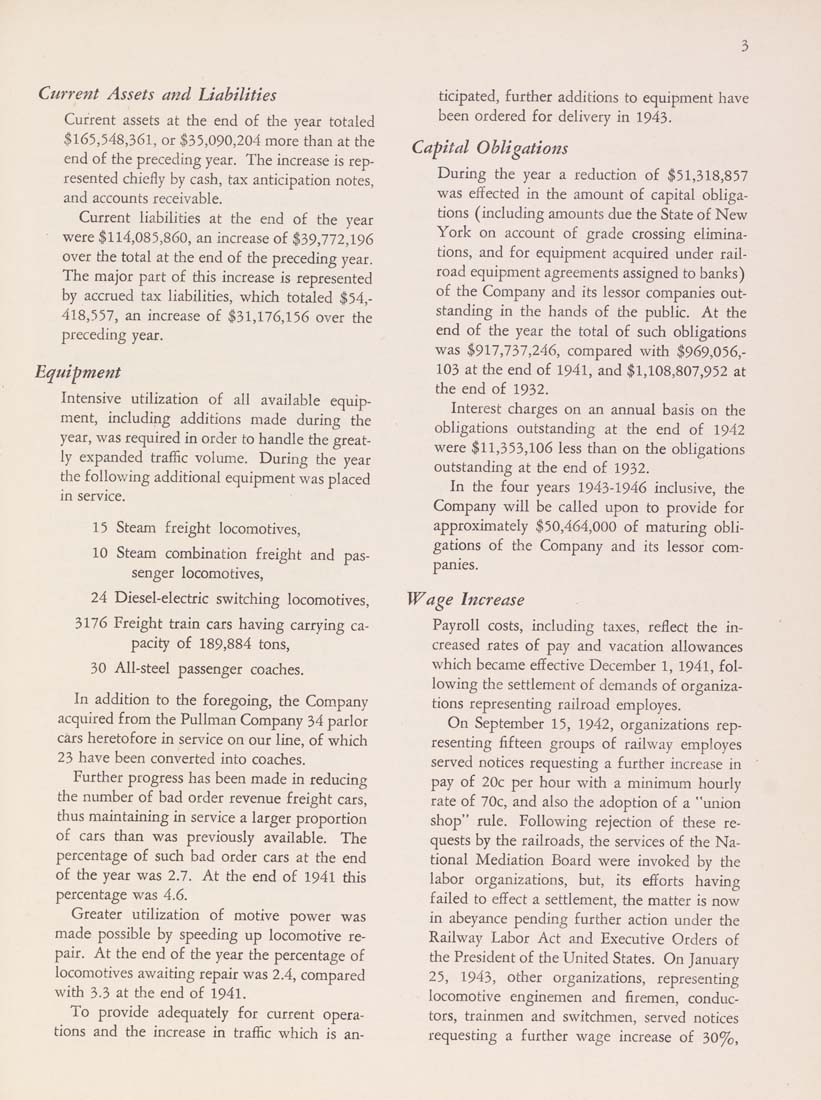Current Assets and Liabilities
Current assets at the end of the year totaled
$165,548,361, or $35,090,204 more than at the
end of the preceding year. The increase is rep¬
resented chiefly by cash, tax anticipation notes,
and accounts receivable.
Current liabilities at the end of the year
■ were $114,085,860, an increase of $39,772,196
over the total at the end of the preceding year.
The major part of this increase is represented
by accrued tax liabilities, which totaled $54,-
418,557, an increase of $31,176,156 over the
preceding year.
Equipment
Intensive utilization of all available equip¬
ment, including additions made during the
year, was required in order to handle the great¬
ly expanded traffic volume. During the year
the following additional equipment was placed
in service.
15 Steam freight locomotives,
10 Steam combination freight and pas¬
senger locomotives,
24 Diesel-electric switching locomotives,
3176 Freight train cars having carrying ca¬
pacity of 189,884 tons,
30 All-steel passenger coaches.
In addition to the foregoing, the Company
acquired from the Pullman Company 34 parlor
cars heretofore in service on our line, of which
23 have been converted into coaches.
Further progress has been made in reducing
the number of bad order revenue freight cars,
thus maintaining in service a larger proportion
of cars than was previously available. The
percentage of such bad order cars at the end
of the year was 2.7. At the end of 1941 this
percentage was 4.6.
Greater utilization of motive power was
made possible by speeding up locomotive re¬
pair. At the end of the year the percentage of
locomotives awaiting repair was 2.4, compared
with 3.3 at the end of 1941.
To provide adequately for current opera¬
tions and the increase in traffic which is an¬
ticipated, further additions to equipment have
been ordered for delivery in 1943.
Capital Obligations
During the year a reduction of $51,318,857
was effected in the amount of capital obliga¬
tions (including amounts due the State of New
York on account of grade crossing elimina¬
tions, and for equipment acquired under rail¬
road equipment agreements assigned to banks)
of the Company and its lessor companies out¬
standing in the hands of the public. At the
end of the year the total of such obligations
was $917,737,246, compared with $969,056,-
103 at the end of 1941, and $1,108,807,952 at
the end of 1932.
Interest charges on an annual basis on the
obligations outstanding at the end of 1942
were $11,353,106 less than on the obligations
outstanding at the end of 1932.
In tlie four years 1943-1946 inclusive, the
Company will be called upon to provide for
approximately $50,464,000 of maturing obli¬
gations of the Company and its lessor com¬
panies.
Wage Increase
Payroll costs, including taxes, reflect the in¬
creased rates of pay and vacation allowances
which became effective December 1, 1941, fol¬
lowing the settlement of demands of organiza¬
tions representing railroad employes.
On September 15, 1942, organizations rep¬
resenting fifteen groups of railway employes
served notices requesting a further increase in
pay of 20c per hour with a minimum hourly
rate of 70c, and also the adoption of a "union
shop" rule. Following rejection of these re¬
quests by the railroads, the services of the Na¬
tional Mediation Board were invoked by the
labor organizations, but, its efforts having
failed to effect a settlement, the matter is now
in abeyance pending further action under the
Railway Labor Act and Executive Orders of
the President of the United States. On January
25, 1943, other organizations, representing
locomotive enginemen and firemen, conduc¬
tors, trainmen and switchmen, served notices
requesting a further wage increase of 30%,
|








